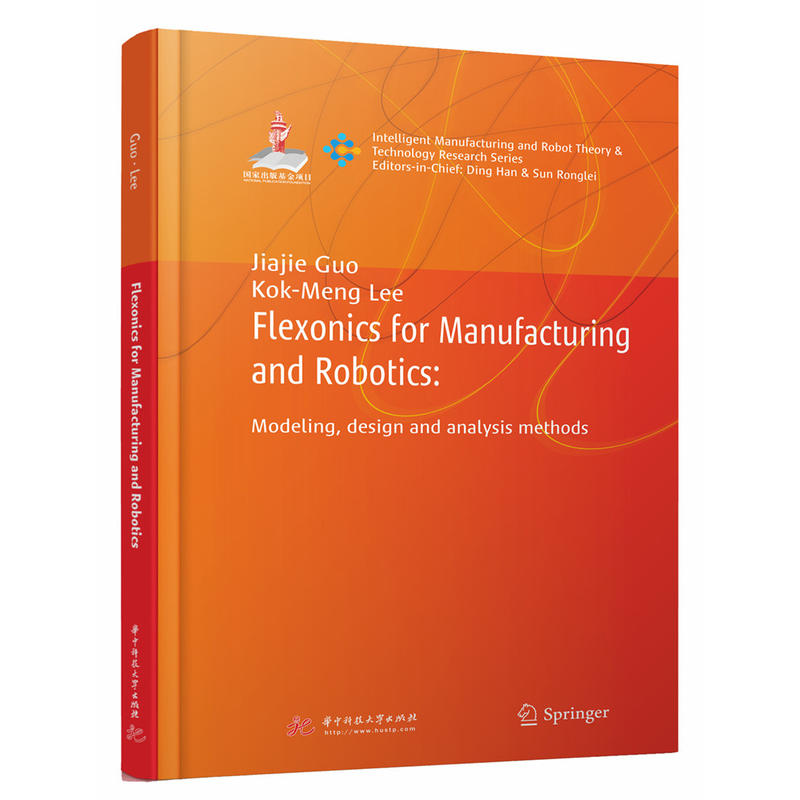
包邮FLEXONICS FOR MANUFACTURING AND ROBOTICS:MODELING, DESIGN AN

温馨提示:5折以下图书主要为出版社尾货,大部分为全新(有塑封/无塑封),个别图书品相8-9成新、切口有划线标记、光盘等附件不全详细品相说明>>
- ISBN:9787568040549
- 装帧:一般铜版纸
- 册数:暂无
- 重量:暂无
- 开本:其他
- 页数:176
- 出版时间:2018-10-01
- 条形码:9787568040549 ; 978-7-5680-4054-9
本书特色
This book formulates the large deformation of a 3-D compliant beam as a boundary value problem (BVP). Unlike other methods, such as finite element (FE) method, that formulate problems based on displacements and/or rotational angles, the BVP formulation has been derived using curvatures that are more fundamental in presenting nonlinear geometries. Since in the case of finite rotation, superposition holds for curvatures but not for rotational angles, the model is much simpler and the resulting computational process is more efficient. The above advantages have been employed in this research to analyze compliant mechanism designs using curvature-based beam models. Along with the method of deriving the compliant members in the same global reference frame, a generalized constraint acting on a compliant mechanism is presented to replace traditional boundary constraints (such as fixed, pinned or sliding constraint) where none or only one degree of freedom (DOF) is allowed. Inspired by the dexterity of a natural biological joint that offers efficient multi-axis rotation, this research extends to the modeling method of a generalized constraint (or referred to here as a bio-joint constraint) to develop designs emulating commonly observed human motions of multi-DOFs . Using a multiple shooting method (MSM), the BVP is treated as an initial value problem and higher order accuracy can be achieved than finite element (FE) methods.
内容简介
This book formulates the large deformation of a 3-D compliant beam as a boundary value problem (BVP). Unlike other methods, such as finite element (FE) method, that formulate problems based on displacements and/or rotational angles, the BVP formulation has been derived using curvatures that are more fundamental in presenting nonlinear geometries. Since in the case of finite rotation, superposition holds for curvatures but not for rotational angles, the model is much simpler and the resulting computational process is more efficient. The above advantages have been employed in this research to analyze compliant mechanism designs using curvature-based beam models. Along with the method of deriving the compliant members in the same global reference frame, a generalized constraint acting on a compliant mechanism is presented to replace traditional boundary constraints (such as fixed, pinned or sliding constraint) where none or only one degree of freedom (DOF) is allowed. Inspired by the dexterity of a natural biological joint that offers efficient multi-axis rotation, this research extends to the modeling method of a generalized constraint (or referred to here as a bio-joint constraint) to develop designs emulating commonly observed human motions of multi-DOFs . Using a multiple shooting method (MSM), the BVP is treated as an initial value problem and higher order accuracy can be achieved than finite element (FE) methods.
目录
作者简介
Jiajie Guo?received the B.S. degree from the Department of Mechanics and Engineering Science at Peking University, Beijing, in 2006, and M.S. and Ph.D. degrees from Mechanical Engineering, Georgia Institute of Technology, Atlanta, in 2009 and 2011, respectively. He is currently an Associate Professor in the State Key Laboratory of Digital Manufacturing and Equipment and the School of Mechanical Science and Engineering at Huazhong University of Science and Technology, Wuhan, China. He is an IEEE and ASME member, and a program committee member of the IEEE/ASME International Conference on Advanced Intelligent Mechatronics. His current research interests include human-centered robotics, flexible mechatronics, manufacturing and system dynamics/control. He has published more than thirty peer-reviewed technical papers in journals and conferences, and has been awarded the best paper award from IEEE/ASME Transactions on Mechatronics in 2015. Kok-Meng Lee?earned his B.S. degree from the University of Buffalo, the State University of New York, Buffalo, NY, USA, in 1980, and S. M. and Ph. D. degrees from Massachusetts Institute of Technology, Cambridge, MA, USA, in 1982 and 1985, respectively. He is currently Professor of Mechanical Engineering at Georgia Institute of Technology, Atlanta, GA, USA. He is also Distinguished Professor with the State Key Laboratory of Digital Manufacturing Equipment and Technology, Huazhong University of Science and Technology, China, under Thousand Talents Plan. Prof. Lee’s research interests include system dynamics/control, robotics, automation, and mechatronics. He is a world renowned researcher with more than 30 years of research experience in magnetic field modeling and design, optimization and implementation of electromagnetic actuators. He has published over 150 peer-reviewed papers and he holds eight patents in machine vision, three degrees of freedom (DOF) spherical motor/encoder, and live-bird handling system. He is IEEE/ASME Fellow and was the Editor-in-Chief for the IEEE/ASME Transactions on Mechatronics from 2008 to 2013. Recognitions of his research contributions include the National Science Foundation (NSF) Presidential Young Investigator, Sigma Xi Junior Faculty Research, International Hall of Fame New Technology, and Kayamori Best Paper awards.?
-

发电厂电气部分
¥34.6¥58.0 -

植物进化的故事
¥19.9¥59.0 -

数控车工
¥5.9¥11.5 -

低空无人机集群反制技术
¥82.6¥118.0 -

数据驱动的剩余寿命预测与维护决策技术
¥63.4¥79.0 -

手术机器人导航与控制
¥127.4¥169.8 -

汽车车身构造与修复
¥30.7¥45.0 -

群目标分辨雷达初速测量技术
¥42.4¥69.0 -

秸秆挤压膨化技术及膨化腔流道仿真研究
¥40.6¥55.0 -

NVH前沿科技与工程应用
¥109.7¥159.0 -

电力系统分析
¥23.8¥38.0 -

继电保护原理
¥30.4¥49.0 -

不确定条件下装备剩余寿命预测方法及应用
¥60.4¥99.0 -

船舶分段装配
¥58.6¥80.0 -

基于深度学习的复杂退化系统剩余寿命智能预测技术
¥54.4¥89.0 -

火星探测器轨道动力学与控制
¥59.8¥98.0 -

工程造价全过程管理系列丛书 工程结算与决算 第2版
¥37.4¥56.0 -

融合多源信息的设备退化建模与剩余寿命预测技术
¥59.8¥98.0 -

和田玉典
¥63.4¥78.0 -

新能源汽车驱动电机及控制技术
¥16.4¥28.0











